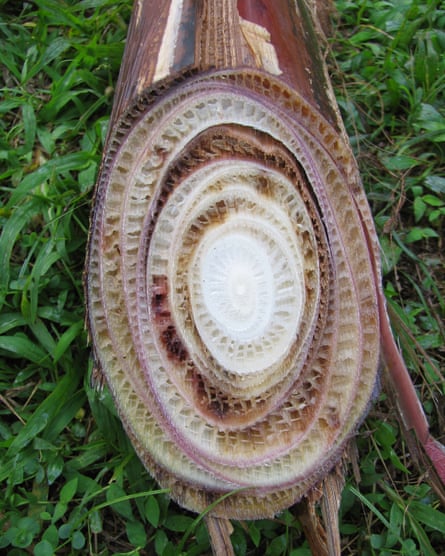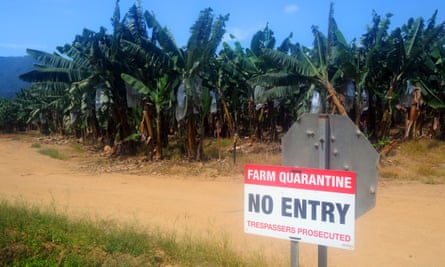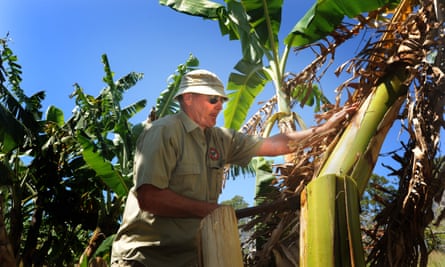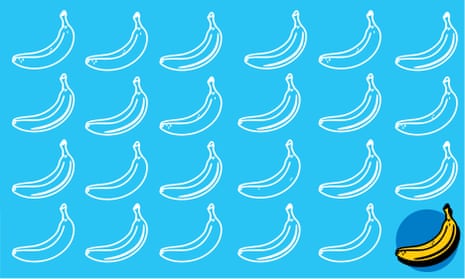Some suggest the banana is on the brink of extinction. Panama disease, also known as fusarium wilt, is on the march, wiping out plantations that provide a staple food for hundreds of millions of people and a livelihood for hundreds of thousands more.
Others say talk of Bananageddon is exaggerated. They point out bananas are as cheap and abundant as ever in our shops. The fungal strain that causes a new form of Panama disease has been spreading steadily for three decades, yet global production has continued to rise. Latin America – where some 80% of exported bananas are grown – has so far kept the pathogen at bay.
So how seriously should we take the doom-mongers? Can banana growers stay one step ahead of their fungal foe, or is its further spread inevitable? What is the role of modern, large-scale monoculture farming in vulnerability to the disease? And how close are scientists to finding a solution?
An earlier form of the disease, caused by a fungus called Fusarium oxysporum f sp cubense race 1, was reported in Australia, Costa Rica and Panama in the late 19th century. It spread across Latin America, devastating production of the Gros Michel, a sweet and creamy banana that dominated the export market. The disease caused mass unemployment, the abandonment of whole communities and economic losses estimated at more than $2.3bn.
By the 1960s, the Cavendish banana, which is resistant to race 1, had replaced the Gros Michel, and today accounts for 99% of global exports. It is the only type of banana that most in Britain and America have tasted.
This switch is, however, increasingly looking like only a temporary fix. A new fusarium strain called tropical race 4 (TR4), which does infect Cavendish plants, was identified in Taiwan in 1990. It has since spread across China and south-east Asia to Australia, Jordan, and Israel. It reached Mozambique in 2013, and earlier this year was reported in India, the world’s biggest producer of bananas.

The TR4 strain is more deadly than race 1. Apart from the Cavendish, it also affects other varieties that together make up 80% of bananas grown worldwide. While other major banana pathogens such as black sigatoka and nematode worms can be controlled if enough pesticides are thrown at them, there is no chemical fix for TR4. Researchers think it is able to lie dormant in soil in the form of survival spores called chlamydospores for more than 40 years.
The fungus gets into the banana plant’s roots and clogs up its vascular system, blocking the supply of water and nutrients, eventually killing it. It is thought to spread through infected plant parts and spores in soil attached to shoes, tools, vehicles, planting materials and water.
The frequent movement between continents of banana industry technical staff leads many scientists to fear that TR4 will eventually reach South and Central America. “It’s only a matter of time,” says Dr Miguel Dita, a plant pathologist at Embrapa, the state-owned Brazilian agricultural research corporation, based in São Paulo. “Many banana industry companies have operations in Asia, Latin America and the Caribbean.”
“It could be a tourist that brings in an ornamental plant,” says Dr Charles Staver, an agricultural scientist at research development organisation Bioversity International, based in Montpellier, France. “Banana industry technicians from Latin America move throughout the world, so there’s also a high risk of them bringing it in.”
While bananas represent a cheap, nutritious snack or dessert in the west, more than 400 million people in Africa, Latin America and Asia rely on them as staple foods, while farming them provides employment for hundreds of thousands more.
“The biggest threat from tropical race 4 is to the millions of people who rely on bananas and plantains as key components of their daily diets,” says Silvia Campos, of Fairtrade International. “They are also a key driver of the rural economies, providing jobs and incomes for workers and smallholders.”
At first glance, it might appear measures to combat the disease are working. Annual global production of bananas, including cooking plantains, grew from 68.2m tonnes in 2000 to 117.9m tonnes in 2015. This is partly because TR4 has spread slowly, but also because some growers have been able to move from infected to disease-free areas – an option that will become less viable as the fungus spreads. “Shifting agriculture is not sustainable over the long term,” says biotechnologist Prof James Dale, of the Queensland University of Technology, Brisbane.
While TR4 can’t be eradicated once established, there are ways to slow its spread. Quarantine measures such as restricting the movement of people, equipment and plant material have helped in some places like Australia, as have practices including treating shoes, farm vehicles, machinery and tools with disinfectants.

Another way to slow it down is by supporting the microbiomes of banana plants. Just as scientists have grown increasingly aware of the importance to human health of the micro-organisms in our guts, so too they are realising how bacteria and fungus that live inside plants – called endophytes – can make them stronger.
Banana propagation for large plantations involves the sterile culturing of plantlets grown from rhizomes, or stems, taken from healthy mother plants. This is done to remove pathogens, but research suggests it can also make plants more vulnerable to pests. “We need to have disease-free planting material. However, when we remove everything, we also remove the beneficial microbes,” says Dita.
The reintroduction of helpful bugs has been used against other banana pathogens. Dita began investigating its potential against Panama disease by investigating some 500 bacteria and fungus living inside banana plants. In a series of tests, he identified those that helped speed or slow Panama disease’s spread, focusing on the older race 1 strain because it is still a problem in Brazil.
He identified two fungi and three bacteria that he says partially protect banana plants from the pathogen, and now farmers are experimenting with the use of plantlets inoculated with them. “Our assumption is that if it works against race 1, then it will work against TR4,” says Dita. “It’s not going to solve the problem entirely, but it could reduce fusarium wilt losses.”
Others say the impact of TR4 could be lessened by changing some of the modern farming methods developed to feed our demand for cheap bananas. Large plantations that grow for export are monocultures, meaning they grow only banana plants. With little crop rotation and lots of tropical sun, pests like TR4 get a steady and abundant supply of food to help them spread. “In nature, a pest is kept under control either through things that predate it or through limited availability of its food,” says Dr Angelina Sanderson Bellamy, an ecologist at Cardiff University. “On large banana plantations, you have mile upon mile of food for pests, and the natural limits on their spread have been removed.”
Sanderson Bellamy and others believe greater biodiversity would make banana farming more sustainable and resilient to threats like Panama disease. One way to do that is through the use of vegetated ground cover. In a study published in 2014, Australian researchers found bananas planted in an area infected with TR4 were 20% less likely to develop symptoms of Panama disease when surrounded with vegetation than those on ground kept bare with herbicides.
Sanderson Bellamy argues large growers should follow the example of small-scale farmers who plant other crops such as avocado, mango, cacao and corn around their bananas. “Greater diversity of plants and associated fungi and bacteria introduces new ecosystem dynamics, which could reduce the pressure of the disease.”
Conventional approaches to selecting individual plants that show greater resistance to disease are less feasible with bananas. Wild bananas are packed with large seeds and have little edible flesh. Banana domestication, which goes back at least 7,000 years, involved the selection by farmers of plants that produced bananas with fewer, smaller seeds. Today’s farmed bananas are sterile. Modern Cavendish bananas are clones, meaning they lack the genetic diversity that usually provides greater resilience to pests and disease to some individuals within a species.

Cavendish bananas may be clones, but they are not entirely identical. Their genes can undergo random mutations and be turned on and off by things in their environment. Scientists at the Taiwan Banana Research Institute have grown millions of tissue-cultured banana plantlets in the hope of generating mutations with improved resistance to TR4. They say they have variants that offer some resistance against Panama disease, but other researchers are divided on their effectiveness.
Moving plantations, adding in helpful microbes, providing more ecological diversity on farms and use of partially disease-resistant mutant plants could all play a role in slowing the spread of Panama disease. None of these options, however, have been shown to eradicate the newer variant of its fungal cause. Research published last year, however, suggests a scientific solution is close.
Dale analysed the genetic makeup of various banana plants, including a wild variety from south east Asia called Musa acuminata ssp malaccensis – which has shown resistance to TR4. He identified and patented two genes thought to be responsible for that protection.
More recently, he genetically modified Cavendish banana plant lines by inserting copies of the most promising of these two genes – called RGA2, then planted them at a site heavily infested with TR4 in Australia. After three years, one of the seven GM banana plant lines remained disease-free, while in three others 20% or fewer plants were infected. Resistance levels varied because the genetic modification technique used meant the inserted gene could end up in different places in the plant genomes, potentially varying their effects. “To get one line showing immunity and three with very little disease from just seven we took to the field was really exciting,” says Dale.
The proportions of four non-GM variants infected during the trial were between 67% and 100%. Cavendish bananas were shown to have less active versions of the RGA2 gene.
A larger, five-year field trial began in September. If the trial goes to plan, Dale hopes he will be in a position to apply for a licence for GM, TR4-resistant Cavendish plants to be made available to farmers by 2023.
Meanwhile, in research published last month, Dale showed it is possibly to turn off a section of Cavendish banana genetic code using the precision gene-editing tool called Crispr-Cas9. He now hopes to develop a gene-edited Cavendish with more active RGA2 genes that is resistant to TR4. Dale estimates it will take seven years to develop and test one to the point it is ready for use.
Others think this is optimistic. “Targeting genes has potential,” says Staver, “but I’d say a commercially available Cavendish variety modified to be TR4-resistant is likely to be more than a decade away.”
In fact, the greatest challenges to producing TR4-resistant bananas may not be scientific. Politicians and judges around the world are currently trying to catch up with the science. The European Union’s court of justice ruled last month that existing GM laws apply to plants and animals created through gene editing. Most observers expect the US and Australia will take a more lenient view.
Dale remains hopeful. “We have GM Cavendish that offers a technical solution to TR4,” he says. “The real challenge now is going to be getting market acceptance. It may be gene edited rather GM bananas that ultimately provide the solution.”

Comments (…)
Sign in or create your Guardian account to join the discussion